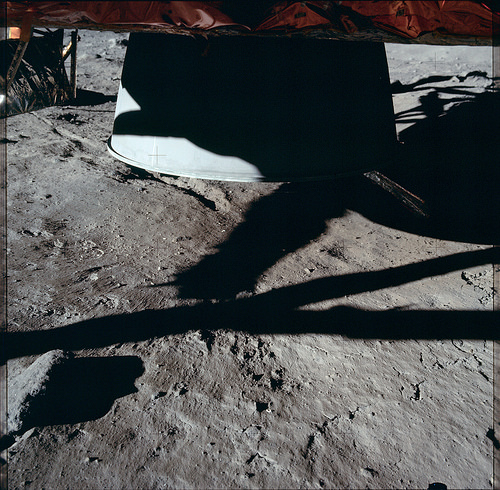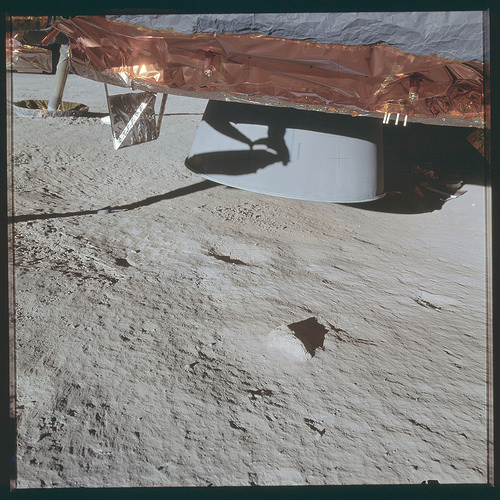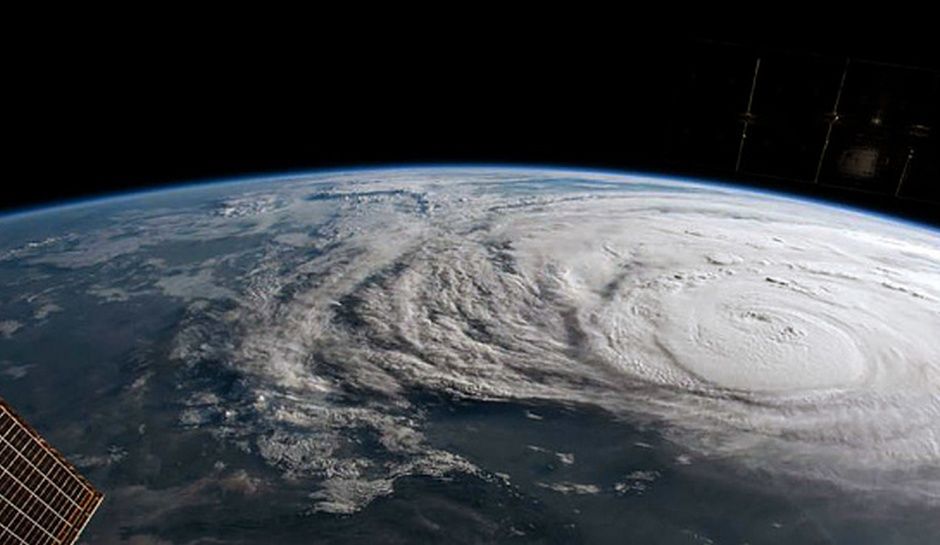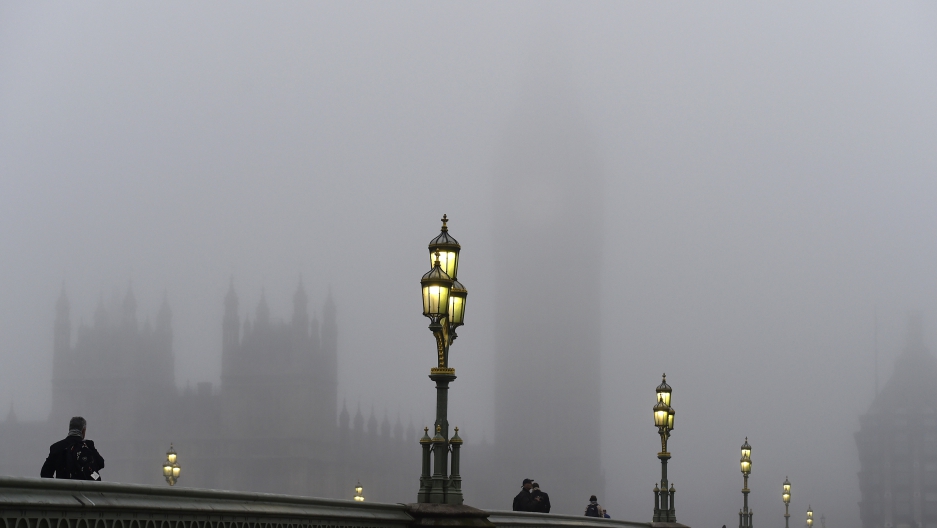It looks like you're using an Ad Blocker.
Please white-list or disable AboveTopSecret.com in your ad-blocking tool.
Thank you.
Some features of ATS will be disabled while you continue to use an ad-blocker.
share:
originally posted by: turbonium1
If you want to prove the moon landings, NASA will lend you a replica Apollo spacesuit.
NASA won't let you pressurize the suit, I'm quite sure. NASA doesn't need to prove that, so just forget about pressurizing it, OK? Good.
Sorry, I do not think American taxpayers will be happy if their money gets spend to test a conspiracy theory. Maybe read through Apollo suit documents and try to build one yourself per NASA specs.
As for NASA giving you a suit: If the suit works, you will just claim it was not made like Apollo suits, so what is the point?
edit on
26-8-2017 by Apollo16UVCS201 because: (no reason given)
originally posted by: Apollo16UVCS201
originally posted by: turbonium1
If you want to prove the moon landings, NASA will lend you a replica Apollo spacesuit.
NASA won't let you pressurize the suit, I'm quite sure. NASA doesn't need to prove that, so just forget about pressurizing it, OK? Good.
Sorry, I do not think American taxpayers will be happy if their money gets spend to test a conspiracy theory. Maybe read through Apollo suit documents and try to build one yourself per NASA specs.
As for NASA giving you a suit: If the suit works, you will just claim it was not made like Apollo suits, so what is the point?
Millions of American taxpayers who don't believe we went to the moon wouldn't mind spending a few cents to test their theory, actually. And how many Americans are happy about their money going down the toilet for wars that are purely invented? Any idea?
A spacesuit either works, as claimed, or it does not work. They can be proven on Earth, and there is no excuse for NASA, or it's supporters, to not allow the public to test them, with NASA on hand, so it's all above board. This assures everyone, on both sides, it is legit. And you cannot dispute the findings, nor can I.
Why wouldn't NASA, and it's flock, want to prove we are wrong, by allowing 100% transparent tests of the Apollo spacesuit?
Because NASA can't prove it works, as claimed, so they will always refuse the public to test it. Simple as that.
a reply to: turbonium1
It would be a funny world we live in if NASA organised public testing of the Apollo EVA suits.
The most rational thing the public can do is get money together for a commercial lander mission to the Moon, landing somewhere near one of the Apollo landing sites and photographing the descent stage and other hardware left there by the Apollo guys.
Still strange how that same public doesn't want to believe the LRO photography of those sites, revealing all that hardware and even astronauts' foot tracks in the lunar soil. www.lroc.asu.edu...
It would be a funny world we live in if NASA organised public testing of the Apollo EVA suits.
The most rational thing the public can do is get money together for a commercial lander mission to the Moon, landing somewhere near one of the Apollo landing sites and photographing the descent stage and other hardware left there by the Apollo guys.
Still strange how that same public doesn't want to believe the LRO photography of those sites, revealing all that hardware and even astronauts' foot tracks in the lunar soil. www.lroc.asu.edu...
originally posted by: wildespace
Still strange how that same public doesn't want to believe the LRO photography of those sites, revealing all that hardware and even astronauts' foot tracks in the lunar soil.
Why'd you mention that!? You don't remember the 30 pages of "shadow wrong cant be seen from this height angle low high blah blah blah"?
Bad, wildespace!
We all know those digital representations of those sites are fake because of the pixels!
originally posted by: wildespace
a reply to: turbonium1
It would be a funny world we live in if NASA organised public testing of the Apollo EVA suits.
The most rational thing the public can do is get money together for a commercial lander mission to the Moon, landing somewhere near one of the Apollo landing sites and photographing the descent stage and other hardware left there by the Apollo guys.
Still strange how that same public doesn't want to believe the LRO photography of those sites, revealing all that hardware and even astronauts' foot tracks in the lunar soil. www.lroc.asu.edu...
The problem is that it completely backfired, fatally.
Images from orbit showed a disturbance on the lunar surface, exactly where a lander is claimed to be.
This was a very exciting discovery, since it meant the LM was at that spot, and when landing down, it made that disturbance of soil, which we can now confirm to be true, in these lunar orbit images!
But there is no 'disturbance' around the LM, in any Apollo surface images.
Which means the Apollo images are faked... obviously.
a reply to: turbonium1
The disturbance can be seen in some photos, but all it is is some fine dust blown off the solid ground. The LM engines were cut off a few seconds before the touchdown (and they were at a low level of thrust), so there wasn't much impact on the ground anyway.
Apollo 11:

www.flickr.com...
Apollo 14:

www.flickr.com...
Some people, for some reason, believe it should have left a crater. But that is obsurd.
The disturbance can be seen in some photos, but all it is is some fine dust blown off the solid ground. The LM engines were cut off a few seconds before the touchdown (and they were at a low level of thrust), so there wasn't much impact on the ground anyway.
Apollo 11:

www.flickr.com...
Apollo 14:

www.flickr.com...
Some people, for some reason, believe it should have left a crater. But that is obsurd.
edit on 2-9-2017 by wildespace because: (no reason
given)
originally posted by: MuonToGluon
We all know those digital representations of those sites are fake because of the pixels!
What on earth does that mean.
Please make you reply specific as I've been working with computer graphics for over 30 years, so I'm likely to be a bit picky.
originally posted by: wildespace
a reply to: turbonium1
The disturbance can be seen in some photos, but all it is is some fine dust blown off the solid ground. The LM engines were cut off a few seconds before the touchdown (and they were at a low level of thrust), so there wasn't much impact on the ground anyway.
Apollo 11:
www.flickr.com...
Apollo 14:
www.flickr.com...
Some people, for some reason, believe it should have left a crater. But that is obsurd.
That's not what I'm referring to.
I am talking about one, specifc feature, seen in the lunar orbit images. Roughly an area no more than 200 m long, and 100 m wide. The area shown in this source...
www.nasa.gov...
This is an actual, physical feature on the lunar surface. It is a DISTINCT feature on the surface.
Any similar-sized feature identified from lunar orbit, would be identified from the surface, as well.
You cannot have a physical feature of ANY type, 200 m X 100 m, identified from 50 km above ground, that is not identified from the ground itself. Because of one important reason - the area BEYOND it would also be identified from the ground, just as from 50 km above it.
There are two very distinct areas here - the area of 'disturbance', and the area surrounding the 'disturbance.
Any distinction is found from orbit, is certainly going to be seen from a closer range.
I've previously challenged anyone to prove me wrong on this. Nobody has ever done so, of course.
The challenge - create some sort of physical feature on the ground that is distinct from the surrounding area. The feature can be up to 20m X 100m in size, or less.
Using any material you choose, create an area distinct from the surrounding area.
Here's the tricky part - the area cannot be distinguished from the surrounding area from the ground. It can only be seen as a distinct area from a great distance. Perhaps from an airplane. Or from a mountain-top.
Attempt to create a distinct feature you have no idea you've even created, until you see what you've created from an airplane!!
Any takers?
originally posted by: turbonium1
That's not what I'm referring to.
I am talking about one, specifc feature, seen in the lunar orbit images. Roughly an area no more than 200 m long, and 100 m wide. The area shown in this source...
www.nasa.gov...
This is an actual, physical feature on the lunar surface. It is a DISTINCT feature on the surface.
Any similar-sized feature identified from lunar orbit, would be identified from the surface, as well.
You cannot have a physical feature of ANY type, 200 m X 100 m, identified from 50 km above ground, that is not identified from the ground itself. Because of one important reason - the area BEYOND it would also be identified from the ground, just as from 50 km above it.
There are two very distinct areas here - the area of 'disturbance', and the area surrounding the 'disturbance.
Any distinction is found from orbit, is certainly going to be seen from a closer range.
I've previously challenged anyone to prove me wrong on this. Nobody has ever done so, of course.
The challenge - create some sort of physical feature on the ground that is distinct from the surrounding area. The feature can be up to 20m X 100m in size, or less.
Using any material you choose, create an area distinct from the surrounding area.
Here's the tricky part - the area cannot be distinguished from the surrounding area from the ground. It can only be seen as a distinct area from a great distance. Perhaps from an airplane. Or from a mountain-top.
Attempt to create a distinct feature you have no idea you've even created, until you see what you've created from an airplane!!
Any takers?
Ever heard of the Nazca lines? Only noticeable from the air...
It's really easy to walk across a grassy area and not see any real differences between slight colour variations caused by soil variations, the topology interacting with light and shadow, dryer/damper patches, different grass types etc.. However, when looked at from above these things become really noticeable. So it's hardly a surprise that the astronauts didn't notice differences visible from above.
a reply to: turbonium1


hurricane Irma viewed from the ground
hurricane Irma viewed from space.
two very distinct areas, spiral clouds and no clouds.. i should see this all the time when viewed from the ground..
as you said easily seen from orbit, should be easy to see when on the ground, right???


hurricane Irma viewed from the ground
hurricane Irma viewed from space.
two very distinct areas, spiral clouds and no clouds.. i should see this all the time when viewed from the ground..
as you said easily seen from orbit, should be easy to see when on the ground, right???
originally posted by: turbonium1
That's not what I'm referring to.
I am talking about one, specifc feature, seen in the lunar orbit images. Roughly an area no more than 200 m long, and 100 m wide. The area shown in this source...
www.nasa.gov...
Ah, thanks for pointing that out, I've never seen that article before and never knew about the "halos". Thing is, as a few posters already mentioned, it's a subtle, large-scale feature that is better visible from high up, not from the ground. That lighter-coloured "halo" is the aforementioned fine dust blown away by the descent engines.
The "halo" is very faintly visible in this LRO image: www.lroc.asu.edu...
Can you see that and honestly tell me you should be able to see it clearly from the ground?
edit on 5-9-2017 by wildespace because: (no reason
given)
originally posted by: turbonium1
I am talking about one, specifc feature, seen in the lunar orbit images. Roughly an area no more than 200 m long, and 100 m wide. The area shown in this source...
www.nasa.gov...
This is an actual, physical feature on the lunar surface. It is a DISTINCT feature on the surface.
Any similar-sized feature identified from lunar orbit, would be identified from the surface, as well.
I'm not sure what it is you would expect to be able to see from the ground. The area in question would still be a dusty lunar surface, but the reason the dust in that area looks subtly lighter than the dust in the surrounding area is that it was disturbed dust.
The disturbed dust reflects light ever-so-slightly differently than the undisturbed dust, maybe due to (and I'm just speculating) the descent engine "fluffing it up" as a fine powder and strewing across the undisturbed surface, after that dust had previously laid undisturbed for a couple of billion years.
But it is still dust. It would be a dusty area surrounded by a dusty area, and the difference would not be that evident from the ground.
That subtle brightness of the disturbed dust is barely visible from above, and it does not have a distinct boundary, but rather a "fuzzy" boundary where the disturbed dust gradually gives way to the undisturbed dust. It is not at all surprising that the difference (i.e., the boundary between them) is not noticeable when you are standing on the surface.
edit on 5/9/2017 by Soylent Green Is People because: (no reason given)
a reply to: Soylent Green Is People
So it would be like if someone mowed a 1-2KM round crop circle in short grass on a field, you would have to climb a tallish hill a couple of KM's away from it to be able to view it?
Or used a brush in the desert to sweep some light dry dirt away from the surface to make a shape a mile across, you would need a tall vantage point to see it?
So if there was a tall hill on the moon several or 10s of KMs away from the feature on the moon, you would be able to partially see it if you climbed it?
(I'm not really asking, I know the answers, it's more for turbonium to get the point, he wanted examples).
So it would be like if someone mowed a 1-2KM round crop circle in short grass on a field, you would have to climb a tallish hill a couple of KM's away from it to be able to view it?
Or used a brush in the desert to sweep some light dry dirt away from the surface to make a shape a mile across, you would need a tall vantage point to see it?
So if there was a tall hill on the moon several or 10s of KMs away from the feature on the moon, you would be able to partially see it if you climbed it?
(I'm not really asking, I know the answers, it's more for turbonium to get the point, he wanted examples).
edit on 5-9-2017 by MuonToGluon
because: Added + Fixed
originally posted by: Soylent Green Is People
originally posted by: turbonium1
I am talking about one, specifc feature, seen in the lunar orbit images. Roughly an area no more than 200 m long, and 100 m wide. The area shown in this source...
www.nasa.gov...
This is an actual, physical feature on the lunar surface. It is a DISTINCT feature on the surface.
Any similar-sized feature identified from lunar orbit, would be identified from the surface, as well.
I'm not sure what it is you would expect to be able to see from the ground. The area in question would still be a dusty lunar surface, but the reason the dust in that area looks subtly lighter than the dust in the surrounding area is that it was disturbed dust.
The disturbed dust reflects light ever-so-slightly differently than the undisturbed dust, maybe due to (and I'm just speculating) the descent engine "fluffing it up" as a fine powder and strewing across the undisturbed surface, after that dust had previously laid undisturbed for a couple of billion years.
But it is still dust. It would be a dusty area surrounded by a dusty area, and the difference would not be that evident from the ground.
That subtle brightness of the disturbed dust is barely visible from above, and it does not have a distinct boundary, but rather a "fuzzy" boundary where the disturbed dust gradually gives way to the undisturbed dust. It is not at all surprising that the difference (i.e., the boundary between them) is not noticeable when you are standing on the surface.
No. The area beyond any disturbance would definitely be found, in many of the surface images.
What is distinct between the two areas is even more distinct, from the surface.
Try to make something invisible from surface, but seen at long distance.....just for fun!
a reply to: turbonium1
You're asking us to go into a desert environment that is similar to the moon...and create a massive ground structure work to simulate the event...to prove it to you.
It's the only way to do what you ask, as whatever example to show you would require a massive size to design in the ground, even if it was not in the desert but in grass.
I don't quite think we are going to do that for you.
You're asking us to go into a desert environment that is similar to the moon...and create a massive ground structure work to simulate the event...to prove it to you.
It's the only way to do what you ask, as whatever example to show you would require a massive size to design in the ground, even if it was not in the desert but in grass.
I don't quite think we are going to do that for you.
edit on 8-9-2017 by MuonToGluon because: Added + Fixed
originally posted by: turbonium1
No. The area beyond any disturbance would definitely be found, in many of the surface images.
What is distinct between the two areas is even more distinct, from the surface.
Try to make something invisible from surface, but seen at long distance.....just for fun!
Fog

according to your theory the closer i am to fog the more likely i am to see it, which is the opposite of what this picture shows and in reality.
originally posted by: MuonToGluon
a reply to: turbonium1
You're asking us to go into a desert environment that is similar to the moon...and create a massive ground structure work to simulate the event...to prove it to you.
It's the only way to do what you ask, as whatever example to show you would require a massive size to design in the ground, even if it was not in the desert but in grass.
I don't quite think we are going to do that for you.
No.
I've simply asked you to support your argument with a real-world example, of any sort.
You say an area isn't seen from close-range, only far above, which contradicts science, then....
This area is visible on the surface, that's the big problem you can't excuse away here.
This area is nothing like a fog bank.
What makes the area distinct from the surrounding area, is a physical difference.
A physical feature.
If we can identify this feature from orbit, it must be quite distinct.
The physical difference can be seen from orbit. It doesn't vanish from sight at close-range.
At close-range, we can finally determine the REASON(S) it is so clearly distinct from the surrounding area!
Very simple concept, really
What makes the area distinct from the surrounding area, is a physical difference.
A physical feature.
If we can identify this feature from orbit, it must be quite distinct.
The physical difference can be seen from orbit. It doesn't vanish from sight at close-range.
At close-range, we can finally determine the REASON(S) it is so clearly distinct from the surrounding area!
Very simple concept, really
originally posted by: MuonToGluon
a reply to: turbonium1
You're asking us to go into a desert environment that is similar to the moon...and create a massive ground structure work to simulate the event...to prove it to you.
It's the only way to do what you ask, as whatever example to show you would require a massive size to design in the ground, even if it was not in the desert but in grass.
I don't quite think we are going to do that for you.
Again, the two areas would be seen on the surface. We'd see it, if they were really on the moon. So it's all faked.
originally posted by: turbonium1
The physical difference can be seen from orbit. It doesn't vanish from sight at close-range.
It kinda does. The apparent visibility also depends on the angle of sunlight. Can you see the difference in this LRO image, for example? www.lroc.asu.edu...
You're arguing very hard for your case, but fail to provide any evidence yourself. As for evidence you're asking for, plenty of it in large-scale formations on Earth that are only identifiable from a plane or orbit, such as large and heavily-eroded impact craters, or the true extent of the Ural mountains southwards for example.
new topics
-
Simple Thanksgiving
Food and Cooking: 2 hours ago -
Trump could make a peaceful American Revolution
US Political Madness: 5 hours ago -
Trump Presidential Transition Team will not use GSA or Government entities to come to DC
US Political Madness: 6 hours ago -
Mind Blowing Cave under someones land
Fragile Earth: 6 hours ago -
The Party of Peace - Trump Cabinet Picks Targeted with Death Threats
US Political Madness: 7 hours ago -
V.P. Kamala Harris releases a video and nobody understands why
US Political Madness: 10 hours ago
top topics
-
D.B. Cooper mystery may be solved
General Conspiracies: 15 hours ago, 21 flags -
V.P. Kamala Harris releases a video and nobody understands why
US Political Madness: 10 hours ago, 16 flags -
The Party of Peace - Trump Cabinet Picks Targeted with Death Threats
US Political Madness: 7 hours ago, 14 flags -
Trump could make a peaceful American Revolution
US Political Madness: 5 hours ago, 13 flags -
Mind Blowing Cave under someones land
Fragile Earth: 6 hours ago, 12 flags -
Trump Presidential Transition Team will not use GSA or Government entities to come to DC
US Political Madness: 6 hours ago, 12 flags -
Simple Thanksgiving
Food and Cooking: 2 hours ago, 4 flags
active topics
-
Simple Thanksgiving
Food and Cooking • 10 • : Bluntone22 -
I thought Trump was the existential threat?
World War Three • 107 • : cherokeetroy -
V.P. Kamala Harris releases a video and nobody understands why
US Political Madness • 65 • : bluesman023 -
The Party of Peace - Trump Cabinet Picks Targeted with Death Threats
US Political Madness • 9 • : DBCowboy -
Trump Presidential Transition Team will not use GSA or Government entities to come to DC
US Political Madness • 9 • : matafuchs -
Post A Funny (T&C Friendly) Pic Part IV: The LOL awakens!
General Chit Chat • 7838 • : GENERAL EYES -
The Acronym Game .. Pt.4
General Chit Chat • 995 • : JJproductions -
Trump could make a peaceful American Revolution
US Political Madness • 8 • : Flyingclaydisk -
Mind Blowing Cave under someones land
Fragile Earth • 14 • : Flyingclaydisk -
President-Elect DONALD TRUMP's 2nd-Term Administration Takes Shape.
Political Ideology • 254 • : WeMustCare
